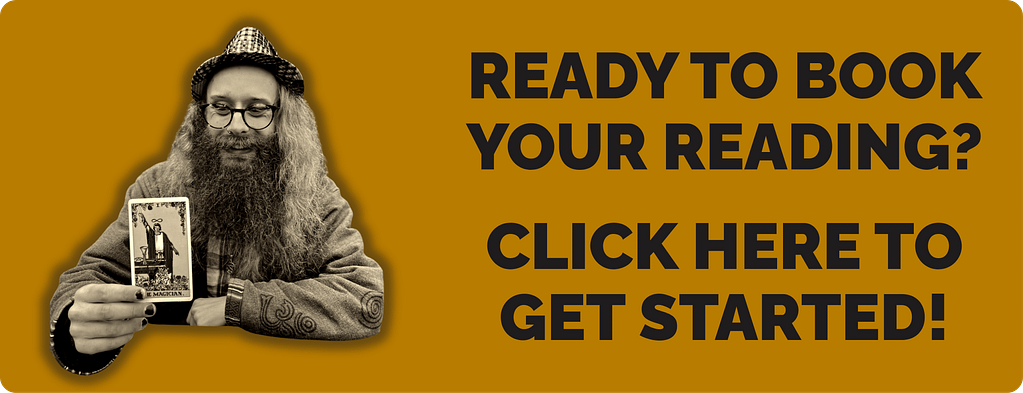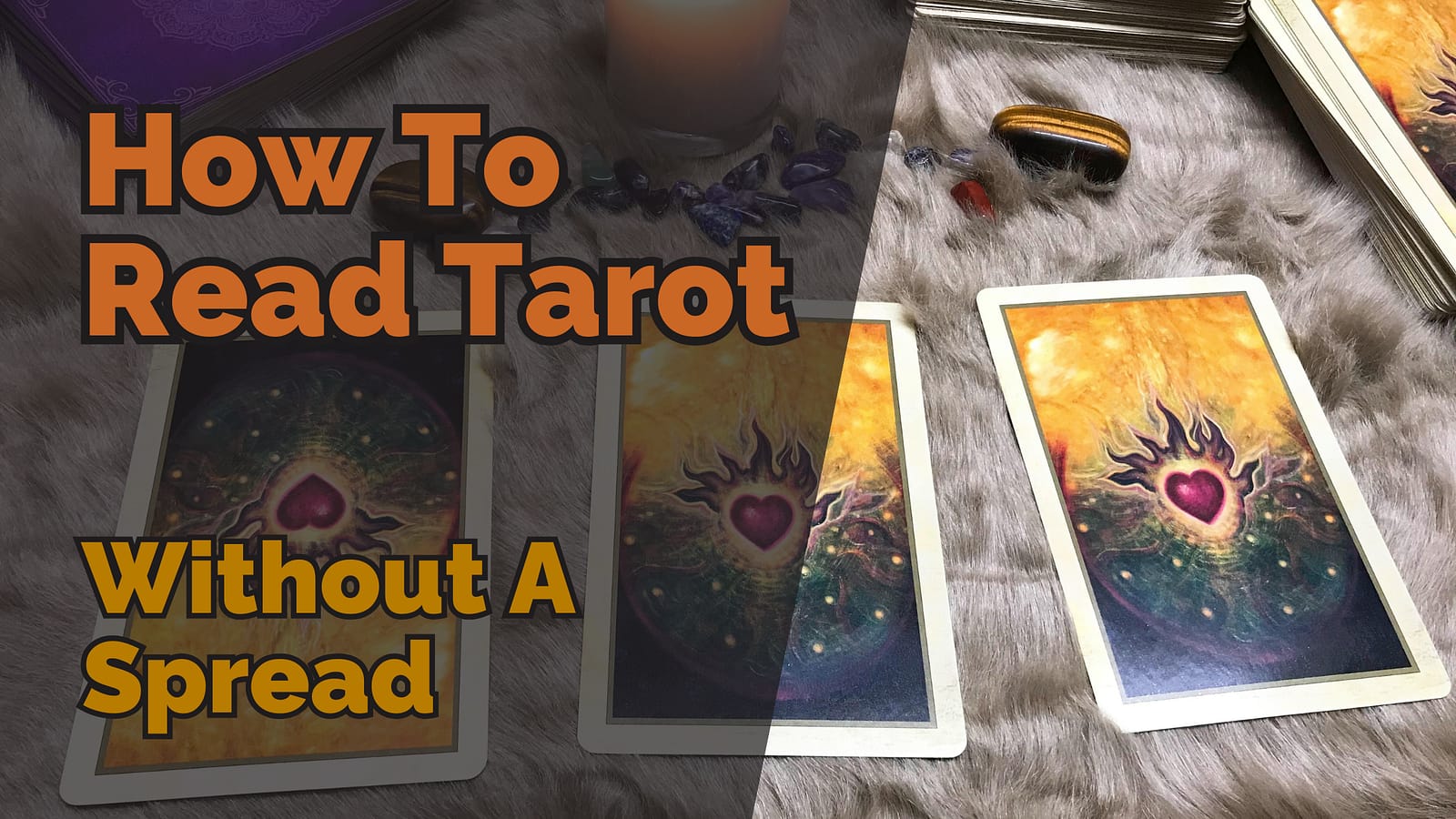
There’s a hidden language in tarot that often gets missed when you’re starting out. Not the symbols, not the suits. The numbers. Every card in the Minor Arcana carries a number, and every number tells part of a larger story. From Ace to Ten, this sequence isn’t just a count. It’s a narrative arc, a pulse that moves through each suit like a heartbeat. Ignore it and you miss the rhythm. But once you start to pay attention, the whole system starts to sing.
In my last post, we broke down the suits as elemental forces: Cups for emotion, Wands for action, Swords for thought, and Pentacles for the material world. But the suits don’t exist in isolation. Each one unfolds over ten steps, ten stages of a journey. The numbers give those stages shape and tension. They let you see where you are in the story, what’s rising, what’s falling, and what kind of work is being asked of you.
Think of it like learning music. The suits are instruments. But the numbers? They’re the notes. And when you learn the meaning behind each number, you stop reading cards one at a time and start reading them as part of a song.
I’m not diving into individual card meanings here. You can explore that on my tarot card meaning pages. But in this post, I’m giving you a numerological lens to work with. One that helps you recognise the patterns, hear the rhythms, and deepen your practice.
The Structure of the Minor Arcana
Four Suits, Ten Cards Each
Each suit in the Minor Arcana contains ten numbered cards, from Ace through to Ten. You’ve got Cups (emotions), Wands (action and energy), Swords (thought and communication), and Pentacles (resources and the material world). These suits form the canvas, with each card acting like a brushstroke in a broader picture of lived experience.
If you read my previous post, you’ll already have a sense of the flavour each suit brings. But what makes these suits so rich is how they move. That movement is shaped by the numbers, which carry the pulse and pace of the story.
Why Numbers Matter in Tarot
The numbers in tarot aren’t random. They’re rooted in numerology, a symbolic system that assigns meaning to numbers as archetypes. In tarot numerology, the number tells you what kind of moment you’re in. What’s the energy doing? Are you at the beginning? Facing a challenge? Reaping a harvest?
These meanings aren’t rigid rules, but they form a backbone. When you learn to read the number and the suit together, the reading deepens. It becomes less about guessing and more about listening.
Reading Beyond the Image
A lot of people get stuck on the image of a card. And to be fair, the pictures are important. But underneath every image is the same structure: a number and a suit. That combination is a kind of shorthand. It tells you the kind of energy at play, regardless of the imagery used.
This becomes especially useful when you’re reading with unfamiliar decks or learning to trust your intuition. The image might vary, but the number remains consistent. It’s a foundation.
The Journey from Ace to Ten
Ace: Beginnings, Potential, Gifts from the Universe

Every suit begins with an Ace. In tarot numerology, Aces represent pure potential. They’re raw, undiluted energy. The Ace of Cups is the first stirrings of love or feeling. The Ace of Swords is a flash of insight or a new idea. Think of Aces like seeds. Nothing has grown yet, but the possibility is there. These cards are invitations. When you pull an Ace, ask yourself: what’s just beginning to take shape?
But potential isn’t always easy to hold. It can be overwhelming, unformed. That’s part of the magic. The Ace doesn’t doanything on its own. It simply is. When you get multiple Aces in a spread, it often signals a fresh chapter, or even a blank slate. They’re the universe handing you something. What you do with it is up to you.
Across the suits, Aces carry the essence of their element in its most distilled form. The Ace of Wands is raw energy. The Ace of Pentacles is opportunity grounded in the real world. The Ace asks you to notice the flicker before it becomes a flame.
Two: Duality, Choice, Reflection

Twos bring contrast. After the singular focus of the Ace, the number Two introduces relationship. It’s you and the other. You and the decision. You and the mirror. In tarot numerology, Twos are moments of tension. Not necessarily conflict, but contrast. There’s a choice to be made, or a balance to be found.
In the suit of Cups, the Two often speaks of emotional connection or partnership. In Swords, it might suggest indecision or mental stalemate. Across the board, Twos invite reflection. What are you noticing? What are you resisting? What needs to be weighed?
When multiple Twos appear, it’s worth paying attention to how your inner world is negotiating with the outer one. Are you making aligned choices? Are you giving your intuition the space to speak? Twos ask you to slow down and consider.
Three: Growth, Collaboration, Expression
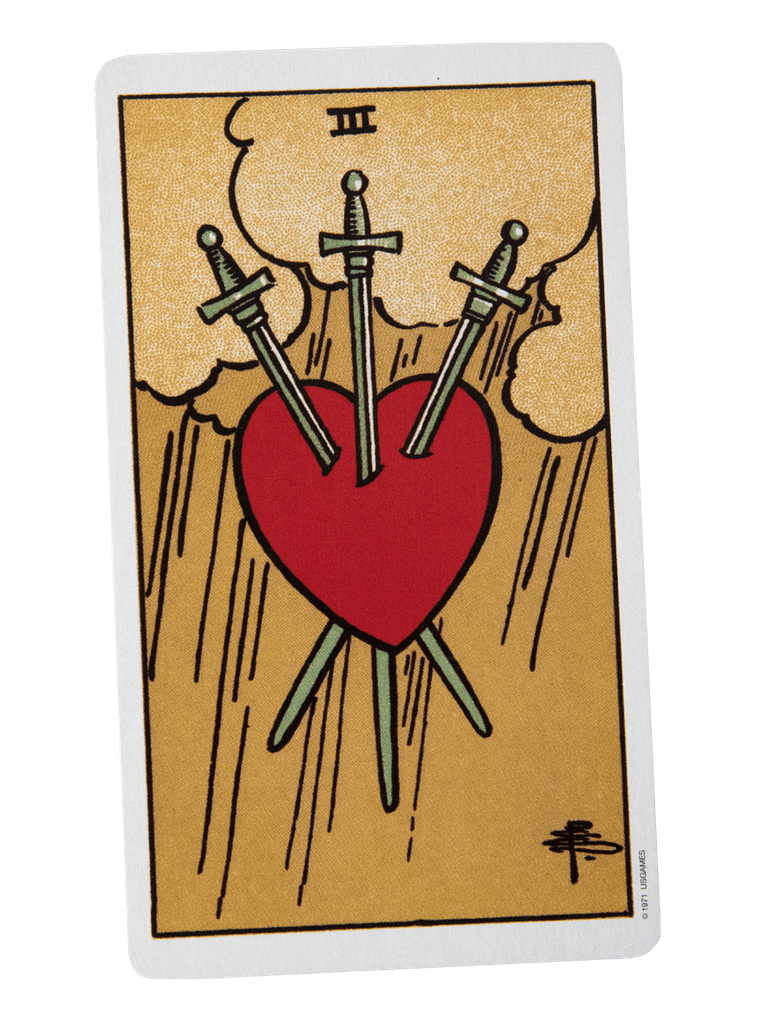
Three is where things start moving. In tarot number meanings, the number Three signals creation. Something has emerged from the union of Two. This could be a project, a plan, or even just an idea that’s ready to be shared.
The Threes often show some kind of expression: celebration, collaboration, communication. The Three of Wands is about vision and expansion. The Three of Pentacles shows teamwork and shared effort. Wherever it appears, the Three asks: what’s taking shape?
But Threes also require support. You’re not quite at full momentum yet. Things are still forming. When Threes show up in a reading, they can invite you to acknowledge what’s growing, and to tend it carefully.
Four: Foundations, Structure, Safety

Fours stabilise. After the outward motion of the Three, the number Four plants its feet. In tarot numerology, Fours are about structure. They’re the walls of a house, the routine of a practice, the baseline of safety. But structure can be both liberating and limiting.
In the Minor Arcana, the Four of Swords might suggest a time-out or pause to regroup. The Four of Cups often points to emotional stagnation or apathy. These cards ask: what foundation are you building on? Is it still serving you?
Fours can offer rest, but also invite review. Is your structure supportive, or has it become a trap? Multiple Fours can highlight where you’re playing it safe, for better or worse.
Five: Disruption, Tension, Crisis Moments

The number Five is where the discomfort sets in. In tarot numerology, Fives represent change. But not always the kind you asked for. There’s tension here. Things are shaken up. The old structures (remember the Fours?) are being tested.
Fives can feel jarring. The Five of Pentacles is a card of material lack or hardship. The Five of Wands suggests competition or struggle. These cards rarely feel easy, but they often mark necessary growing pains.
When Fives appear, you might be in the middle of a recalibration. Something’s not working anymore. What do you need to let go of? What are you clinging to out of fear?
Six: Harmony, Recovery, Balance Regained

After the storm of the Five, the Six brings relief. In tarot numerology, Six is a number of healing and restoration. It’s not that the problem has vanished, it’s that you’re moving through it with more grace.
The Six of Swords literally shows a journey away from trouble. The Six of Cups brings nostalgia and emotional ease. Across the suits, Sixes are about returning to centre. Not perfection, but balance.
If Sixes show up in your reading, it’s a good moment to ask: what helps you feel grounded? What practices or relationships restore your sense of self?
Seven: Inner Work, Reassessment, Strategy
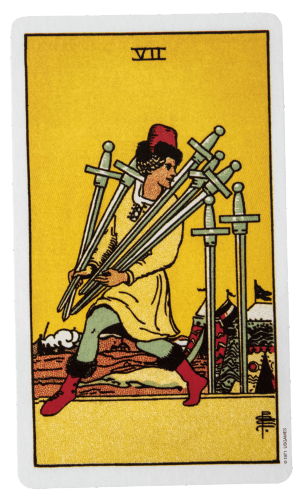
Sevens pull us inward. In tarot number meanings, the number Seven often marks a turning point. It asks you to pause, reassess, look within. You’ve made progress, but now you need to consider what’s really working.
The Seven of Swords might point to strategic thinking or even deception. The Seven of Pentacles invites reflection on what you’ve planted and whether it’s bearing fruit. These aren’t always easy cards, but they are thoughtful ones.
Multiple Sevens can suggest a moment of inner recalibration. What’s driving your choices? Are you acting from alignment or avoidance? The Seven gives you a chance to check in.
Eight: Momentum, Mastery, Resilience
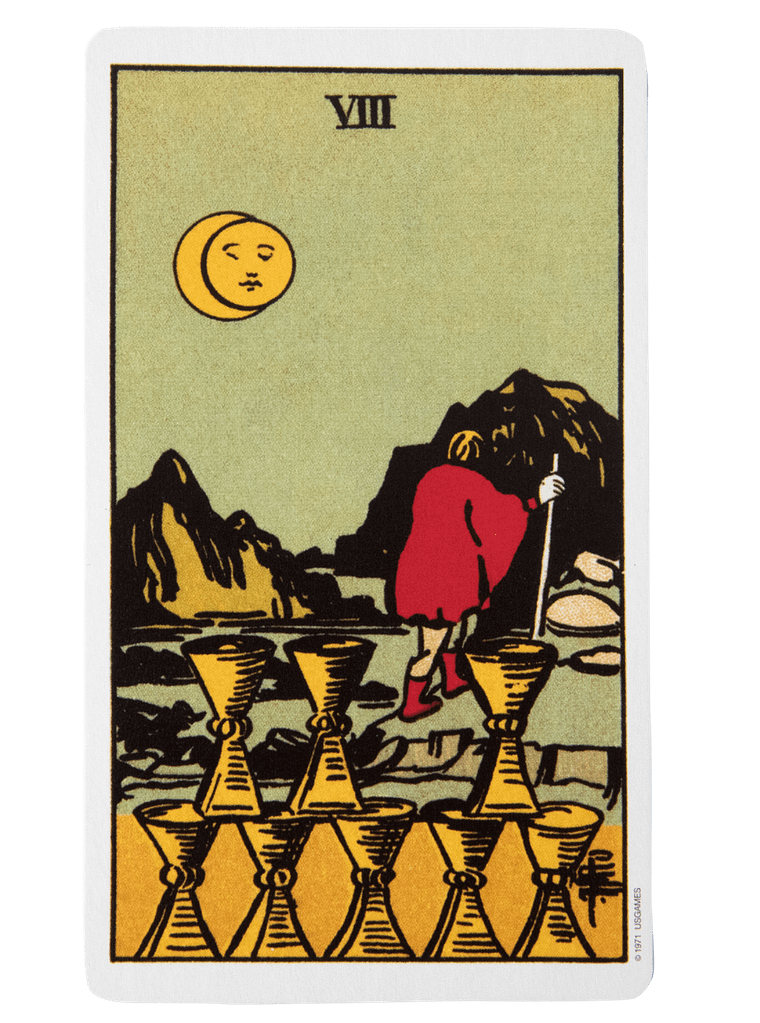
Eights are about movement. In tarot numerology, the number Eight carries themes of power, persistence, and progress. You’re in the thick of things now, and the work is real.
The Eight of Wands is rapid motion. The Eight of Pentacles is steady, focused effort. These cards often show momentum, but not without effort. What you’ve learned so far is being put into practice.
When Eights show up, you might be mastering a skill, deepening a relationship, or navigating a challenge. Whatever the context, the energy is forward-focused.
Nine: Nearing the Peak, Self-Reflection

The number Nine is close to completion. In tarot numerology, Nines are about integration and insight. You’re almost there, but not quite. There’s a reflective quality to these cards, a pause before the finale.
The Nine of Swords speaks to anxiety or overthinking. The Nine of Cups is emotional satisfaction. Together, these cards remind us that the final stretch can bring both clarity and doubt. What needs to be seen before you move on?
When multiple Nines show up, you may be being called to check your inner world. Is your progress aligned with your values? What truths are surfacing now?
Ten: Culmination, Legacy, Ending and Renewal

Tens complete the cycle. In tarot number meanings, the number Ten symbolises fulfilment, but also transition. The journey doesn’t end. It resets. There’s a sense of culmination here: the full weight of the suit has played out.
The Ten of Wands shows the burden of responsibility. The Ten of Pentacles paints a picture of long-term stability. Whatever the flavour, Tens show what happens when the energy of the suit reaches its peak.
Tens can feel final, but they also open the door to the next chapter. When they appear, ask yourself: what’s ending, and what’s beginning again?
Patterns and Possibilities
Spotting Recurring Numbers in a Spread
Sometimes, it’s not the suit that catches your eye, it’s the number. When you see multiple cards with the same number, pay attention. Two Threes might mean something is trying to grow. A cluster of Fives could signal that tension is rising across different parts of your life.
Numbers can echo across a spread. They bring rhythm and pattern. Noticing them adds another layer of insight, helping you see the reading as a whole instead of just card by card.
Numbers as Archetypes
The numbers in tarot aren’t just markers, they’re symbols. Each number holds an archetypal energy. When you learn what each one carries, you start to see those themes in your own life.
You might notice that your personal story always seems to hit a wall around the Fours, or that Sevens keep showing up when you’re reassessing your career. These patterns aren’t rules. They’re invitations to pay attention.
Thinking of numbers as archetypes lets you read more intuitively. It gives the cards room to speak through repetition, contrast, and flow.
When a Number Breaks the Pattern
Not every card follows the expected vibe of its number. The Four of Cups, for example, doesn’t always feel stable. The Seven of Swords can be more about strategy than inner reflection.
When a card feels like an outlier, don’t ignore it, interrogate it. What is it trying to show you about the nature of that number in this moment? Maybe your sense of stability is off. Maybe your strategy is being used for avoidance.
Breaking the pattern doesn’t mean the system is broken. It just means the reading is trying to get your attention in a different way.
So how do you start applying this in your own readings?
Tips for Working with Tarot Numbers
Journalling Prompts
If you’re learning tarot, one of the best things you can do is journal. When numbers repeat in your readings, write them down. What were you feeling? What was happening in your life?
Start prompts like: “What am I building right now?” (Four) or “What am I being asked to release?” (Five). These small reflections build your intuitive muscle over time.
The more you write, the more you notice. And the more you notice, the deeper your readings go.
Questions to Ask When Numbers Repeat
When you see a number show up more than once, stop and ask: What’s the theme here? What’s this number asking of me? Am I resisting it, or ready to move with it?
These questions help you step back and see the big picture. Sometimes the same number across different suits can show a life-wide pattern. Other times, it’s pointing to a specific issue showing up in multiple disguises.
Sort Your Deck by Number
If you want to get to know the Minor Arcana better, try sorting the cards by number instead of by suit. Put all the Twos together. Then all the Threes. Notice what’s similar, and what’s not.
This practice lets you see the shared numerological theme underneath the elemental differences. You might spot that Fours tend to feel stuck, or that Sevens all ask you to stop and think.
It’s a great way to start learning the system without memorising every single card meaning.
Let the Numbers Guide You
Numbers won’t tell you everything in tarot, but they’ll tell you more than you think. They offer structure, rhythm, and a thread that weaves through the suits. Once you start noticing how each number plays out, your readings get deeper. Sharper. More intuitive.
So stay curious. Pay attention to the patterns. Which numbers keep turning up in your spreads? What story are they telling?
If this post helped you see tarot in a new way, check out my workbook Simply Tarot, join my beginner-friendly tarot course of the same name, or browse my in-depth card meanings. And keep an eye out for the next post in this series, where I’ll dive into the Court Cards.

